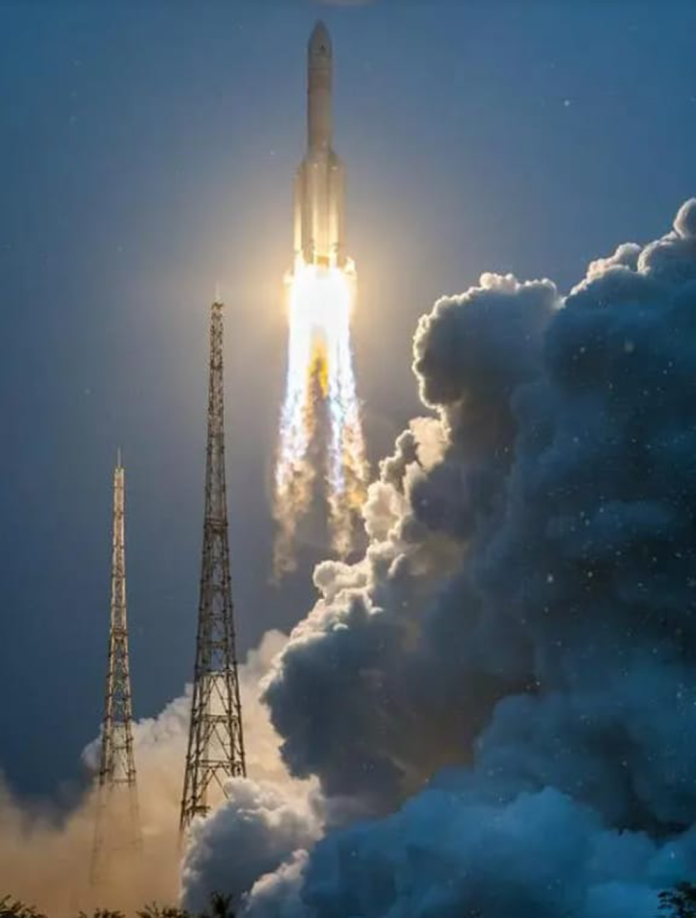As Pak-China cosmic collaborations go full steam ahead, China’s Chang’e 6 2024 lunar mission partnered by Pakistan’s science payload has been launched with high-octane enthusiasm on May 3 (Friday), offering tenacious glimpse of a brand-new pivot in Pak-China space and lunar explorations.
With the launch of Pakistan’s lunar satellite, “ICUBE-Q”, scheduled for liftoff with China’s Chang’E6 spacecraft from Hainan, hopes are blossoming for mission’ wide-ranging breakthroughs.
This joint endeavor not only marks a monumental leap forward in Pakistan’s space exploration journey but also prop up the profound bond between the two nations.
It symbolizes Pakistan’s ascent into the realm of cosmic exploration and underscores the unwavering camaraderie shared between Pakistan and China. With the successful launch, anticipation mounts that groundbreaking mission will unravel the mysteries of the moon’s dark side. The probe is set to collect samples from the far side of the moon, making this mission the first of its kind in human history.
The inception of the ICUBE-Qamar project stemmed from China’s invitation to member states of the Asia Pacific Space Cooperation Organization (APSCO) to participate in its lunar exploration mission. Pakistan, through its Institute of Space Technology (IST) and the Pakistan Space and Upper Atmosphere Research Commission (SUPARCO), seized this opportunity to collaborate with China’s Shanghai Jiao Tong University (SJTU) in designing and developing the CubeSat.
ICUBE-Qamar, weighing approximately seven kilograms, is equipped with two one-megapixel optical cameras to capture images of the lunar surface. Its primary objectives include recording the release process from the Chang’e 6 orbiter, transmitting beacon signals to confirm successful operation, and capturing images of the Earth, Moon, and orbiter.
Additionally, the CubeSat aims to gather data on the lunar magnetic field, laying the groundwork for future international cooperation in lunar exploration. CubeSats, characterized by their compact size and modular design, offer cost-effective opportunities for scientific research and technology development in space exploration.
It’s a great feat for Pakistan, as this mission will put Pakistan with the league of developed nations of Europe including France, Italy, Sweden, Switzerland and obviously Asian economic and tech giant China.
Looking ahead, Pakistan’s participation in the Chang’e 6 mission paves the way for future collaboration with China in space exploration. The two countries are set to embark on ambitious plans, including the construction of a research station on the lunar south pole as part of the International Lunar Research Station (ILRS) project. This collaboration underscores Pakistan’s strategic alignment with China in advancing space exploration initiatives and fostering scientific cooperation.
In the shadow of India’s recent success in lunar exploration, Pakistan finds itself in a position to assert its scientific prowess and stand tall amidst comparisons with its arch-rival. While India’s achievements in space have garnered international acclaim, Pakistan’s participation in China’s Chang’e 6 mission represents a significant stride in its own space exploration endeavors.
This satellite will also support future missions, including Chang’e-7 and 8, aimed at exploring the lunar south-pole and constructing a base in collaboration with Russia. Despite concerns from NASA about Beijing’s polar ambitions, China emphasizes its commitment to cooperative endeavors.
Even though various European countries are collaborating with China on this mission but United States has taken measures to restrict China’s space missions due to geopolitical tensions. This includes a ban on direct or indirect collaboration between NASA and China, imposed by US law. The rationale behind these restrictions stems from perceived risks associated with sharing sensitive technology and information with China, as well as concerns about China’s growing influence in space exploration. Moreover, the US has expressed apprehensions about China’s intentions in claiming lunar resources, particularly water, which could potentially lead to disputes over space resources. These restrictions reflect broader efforts by the US to assert dominance in space and maintain its position as a leader in space exploration. Despite these challenges, China remains undeterred in its pursuit of scientific advancement and international cooperation, demonstrating resilience and innovation in its space missions.
As Pakistan navigates financial instability, the ICUBE-Q mission has the potential to elevate the country’s international standing and cultivate a positive image on the global stage. By demonstrating Pakistan’s capabilities in space exploration and fostering collaboration with international partners, the mission can attract attention and admiration from the global community. This enhanced reputation can lay the groundwork for future foreign investments, partnerships, and economic opportunities, ultimately contributing to Pakistan’s long-term financial resilience and prosperity.
Pakistan’s involvement in China’s lunar mission signifies a pivotal moment in the country’s scientific journey and reinforces the enduring friendship between Pakistan and China. As China embarks on its ambitious plan to land astronauts on the moon before 2030, Pakistan’s collaboration in the Chang’e missions underscores its growing role in the global space community.


